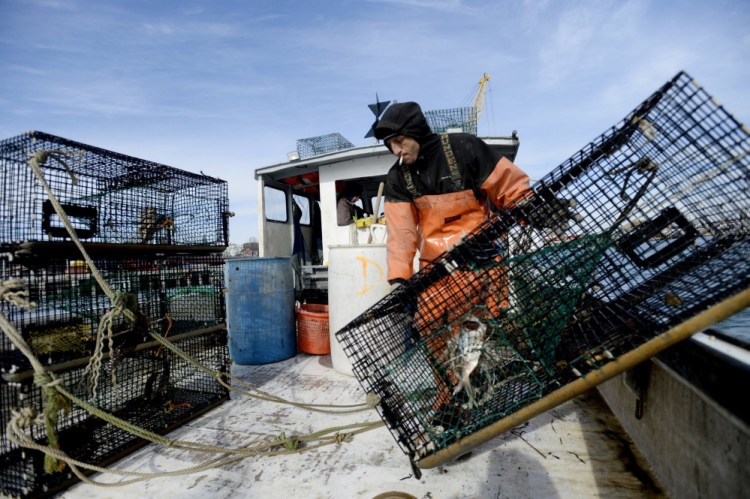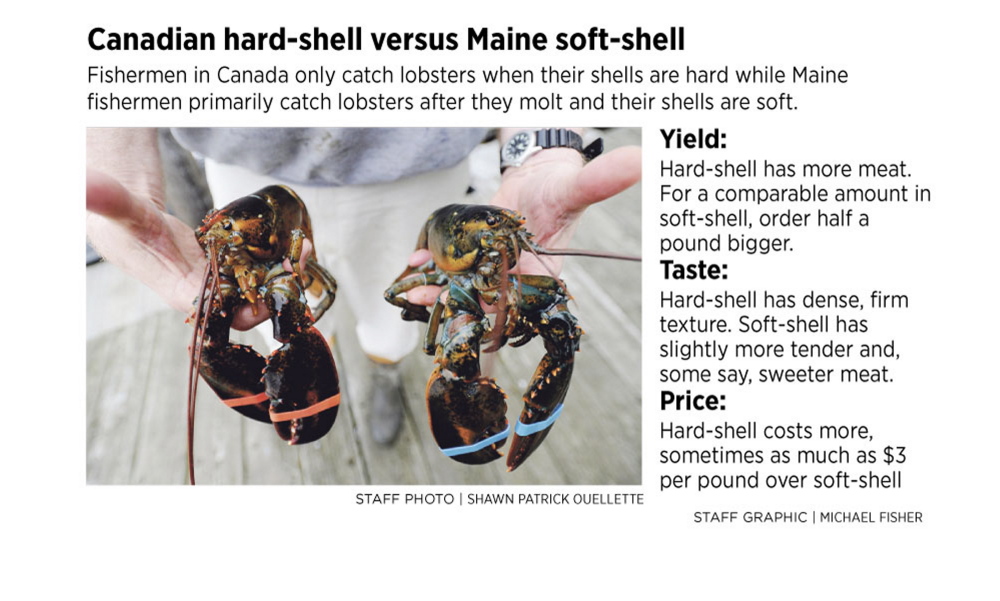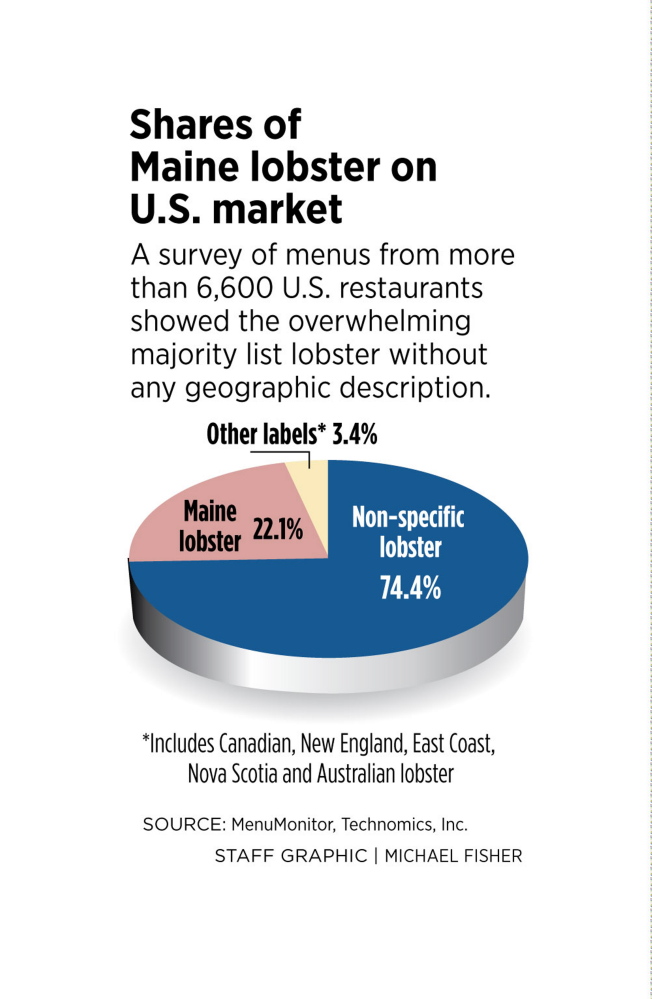Maine’s lobster industry is launching an ambitious marketing campaign to boost prices by convincing consumers that Maine lobsters are sweeter and tastier than those caught in Canadian waters.
Not surprisingly, Canadian lobster officials scoff at the notion, saying the lobsters are the same species and the effort is just a public relations stunt.
But the Maine Lobster Marketing Collaborative intends to prove them wrong by spending nearly $6 million over the next three years on the industry’s first-ever comprehensive marketing effort. The group has hired a global public relations firm, Weber Shandwick, to craft and deliver the message; this year the focus is on reaching out to chefs in upscale casual restaurants in the Northeast, the top market for Maine lobsters.
The goal: convince restaurants that Maine’s soft-shell lobsters are a seasonal delicacy with a story.
The level of spending – funded by a surcharge on licenses issued to lobstermen, processors and dealers – is unprecedented. The marketing collaborative will spend $1.5 million this year and $2.2 million each of the next two years. The campaign is “groundbreaking” because it’s the first time there’s been an industrywide effort to build a brand for Maine’s lobsters, said Patrice McCarron, executive director of the Maine Lobstermen’s Association. The effort was kicked off this year with a menu survey of more than 6,600 restaurants to show how lobsters are described and prepared for diners.
Maine’s efforts have caught the nervous attention of the Canadian lobster industry, which has been unable to marshal a similar marketing effort because the federal government regulates the fishery and trade groups lack the political clout of Maine’s lobstermen.
Maine fishermen for the most part harvest soft-shell lobsters during the summer. Fishermen in Canada’s Atlantic provinces target hard-shell lobsters, which fetch a premium price – as much as $3 more per pound – because they’re stuffed with meat and survive in greater numbers when shipped long distances. The Canadians fish in deeper waters in the late fall, winter and spring when the lobster shells are hard.
Geoff Irving, executive director of the Canadian Lobster Council, based in Halifax, Nova Scotia, said he doesn’t see how the lobsters caught by Maine fishermen can taste better.
“It’s the same species. Maine lobster is no different than Nova Scotia lobster,” he said. “We all have got the same beast, and everyone is trying to market it in a different way.”
EFFORT TO BOOST DEMAND
The push to ramp up Maine’s lobster marketing began in 2012 after fishermen saw the average price for their catch sink to $2.69 per pound, its lowest level in nearly two decades. The Legislature established the marketing cooperative the following year. The lobster harvest last year brought in $456 million to fishermen, making it by far Maine’s most valuable fishery.
There are only two ways to boost prices: limit supply – a tactic fraught with political peril – or increase demand, so fishermen are willing to support the higher lobster trap fees to boost marketing efforts, said David Cousens, president of the Maine Lobstermen’s Association.
“People are coming to the realization that more marketing of the product means more value in your product,” he said.
Despite its iconic status in the state, Maine lobster has become a commodity in the marketplace, according to the group’s market research.
For example, in China – a growing market for lobsters – buyers classify Canadian lobsters as “No. 1” lobsters while soft-shell lobsters from New England are stuck with “No. 2” status. More than 80 percent of the lobsters in the United States are harvested in Maine.
The Maine lobster industry for too long has allowed lobsters to be graded by their ability to be shipped long distances rather than how they taste, said Matt Jacobson, executive director of the collaborative.
“You don’t eat the shell,” he said. “If you talk to the chefs and the people who eat lobsters, they prefer soft-shell lobsters. It tastes better,” he said.
The lobsters caught by Maine fishermen and Canadian fishermen are the same species, Homarus americanus. The difference is the time of year they’re caught.
Maine fishermen are permitted to catch lobsters in state waters year-round but mainly harvest them in the summer and early fall after the crustaceans move to inshore waters and crawl out of their tight-fitting shells. They then grow new shells that take months to harden. The lobsters in the summer are easier to catch because they’re in state waters closer to shore, hungrier and move around more.
Canadian lobstermen avoid lobsters that have shed their shells because they contain less meat, said Irving of the Canadian Lobster Council.
“We try to avoid lobsters when they are molting,” Irving said. “That’s because they are empty and don’t yield well.”
CROSS-BORDER FISHERIES WORK AS ONE
The Maine and Canadian seasons are sequential, so there’s a steady supply of fresh lobsters for the dealers and processors on both sides of the border. The year-round supply of fresh lobster also sustains the market among consumers. About 70 percent of Maine lobsters are exported to Canada, where they are processed. Many of them are re-exported to consumers in the United States but without the “Maine” label.
For the most part, the fisheries in Canada and Maine work as one industry to the benefit of everyone. When it comes to price, though, the arrangement doesn’t work as well for Maine fishermen.
In 2014, for example, Maine lobster landings peaked in August, but the price per pound that month was the lowest of the year at $3.21 per pound, according to preliminary state data.
The price peaked in March and April, at $6.70 a pound. That’s the time of year, though, when Canadians are catching hard-shell lobsters and Maine fishermen are still sitting at home or working on their boats.
About 20 percent of Maine lobstermen hold federal permits that allow them to catch hard-shell lobsters in offshore waters in the winter, but the number of permits is limited. In addition, fishing offshore requires going greater distances and fishing in deeper waters, which call for a bigger investment to pay for larger vessels and engines, more rope and a larger crew.
MARKETERS: EMBRACE ‘NEW SHELL’
Despite the current price edge enjoyed by the Canadians, Maine’s lobster industry is well-positioned to take advantage of growing interest among American consumers who value seasonal foods harvested sustainably, said Patty Stone, an executive vice president at Weber Shandwick.
Many consumers today are shunning industrialized food production and paying more for food that can be sourced to a particular farm or fishing port, she said. The marketing group hopes to take advantage of the boat-to-table food trend by marketing Maine’s lobsters as a seasonal delicacy that is “fished the hard way – one trap at a time,” according to its marketing materials. The group also plans to market Maine lobsters as “protein with provenance,” borrowing a phrase used by museum curators to indicate the place of origin for an artifact.
“There is nothing more important now than the story you can tell around the food,” Stone said.
The marketing collaborative wants fishermen and dealers and even Maine residents to get on-board with the campaign and start talking about Maine lobsters differently. Forget the terms “soft shell” and “shedders, ” the group says. Instead, call them “new shell” lobsters, a name the marketers believe connotes freshness and seasonality – attributes that are increasingly desirable in the marketplace.
“I want everyone in Maine to think about lobsters a little differently and realize it’s a special product that comes at a special time,” Stone said. “It has been taken for granted. It’s the sweetest, the most tender and ‘lobster-y’ meat, and we should be celebrating that.”
The group hangs this claim of Maine lobster superiority on a blind taste test conducted by serious eats.com, one of the nation’s most well-known food blogs.
The test is based on overall preference, lobster aroma, sweetness and brininess.
The results: Tasters almost unanimously preferred the soft-shell lobsters to the hard-shell, citing its “tenderness, sweetness, and ‘lobster-y’ flavor,” according to the writer, J. Kenji López-Alt, a restaurant-trained chef and former editor at Cook’s Illustrated magazine.
Stephanie Nadeau, a lobster dealer in Arundel who sells lobsters from Canada and Maine, said meat from soft-shell lobsters is more translucent while the meat from hard-shell lobsters is more chalky.
“I don’t eat nasty hard-shells,” she said.
CAPITALIZING ON THE FOOD’S STORY
Nadeau said she likes the marketing plan because there is strong consumer demand for food that is seasonable and sustainable.
People in Maine are so accustomed to seeing lobstermen at work that they take the fishery for granted and don’t realize that consumers in the rest of the country crave this kind of intimate connection with a wild food source, said Nick Branchina, director of marketing for Portland-based Browne Trading Co., which sells seafood to high-end restaurants.
“For people from away, this is wonderful stuff,” he says. “From a marketing standpoint, you tell the story. You capitalize on that.”
Stone said the campaign will focus on telling the story to star chefs in the Northeast because they influence the entire restaurant scene. Weber Shandwick will bring chefs and food bloggers to Maine this summer to see how lobsters are harvested and experiment with new recipes. While Mainers like their lobsters to be prepared simply and served as the center of the plate, as in a traditional lobster bake, chefs elsewhere see lobster meat as an ingredient for exotic dishes, according to a survey of menus from more than 6,600 restaurants conducted by the research firm Technomic. One restaurant in New York, Oceana Restaurant, for example, serves a lobster in a spicy sweet-and-sour sauce in a dish it calls “General Tsao’s Lobster.”
In addition, Weber Shandwick will conduct a head-to-head taste test between soft-shell and hard-shell lobsters with chefs and also try to get the taste test on television shows, like “Today” and “Good Morning America.”
Cousens, who is a lobsterman in South Thomaston, said he and many other fishermen will do their part and start calling lobsters by the name preferred by the marketing people.
“As far as taste, the shedders” – Cousens interrupted himself – “the new shells win every time.”
He laughed. “I am not supposed to call them shedders. I’m supposed to call them new shells. I am trainable.”
Send questions/comments to the editors.






Comments are no longer available on this story